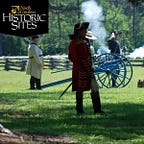Dr. Haslen & the Nurses of Alamance: The Caregivers
Men and women work to save the many wounded after the battle
Part of “The Lives of His Majesty’s Subjects: Stories of the Battle of Alamance”
Immediately after the battle, the militia began bringing back their wounded, 61 men in all, along with some wounded Regulators to their encampment along Great Alamance Creek. Governor Tryon directed that the wounded be cared for near his tent. Two surgeons and a hospital steward tended to those wounded in battle but the work was overwhelming. Two days after the battle, Tryon ordered those still in need of care to be sent to Michael Holt’s plantation, and for the surgeons to hire local women to serve as nurses, and furnish them provisions from the commissary. After securing means for the care of the wounded, Tryon’s army marched deeper into Regulator territory. These nurses and the established hospital staff cared for those unable to continue on the campaign while the army marched west.
No one knows how many Regulators died or were wounded on the battlefield. Afterwards, Regulator sympathizers opened their homes to provide what care they could. With few doctors available Regulator leader Herman Husband was compelled to travel to the Moravian settlement of Bethabara to try and get additional help. There, he tried to ask Dr. Jacob Bonn for help, but was turned away.
Dr. Thomas Haslen
Tryon appointed Thomas Haslen, a doctor from New Bern, as one of two “Surgeons of the Army.” The surgeons held the responsibility of caring for the health of the army. This job often meant more than just dealing with battle wounds. Conditions in 18th century military camps were breeding grounds for disease, and poor health could devastate an army even more than a battle. After the army left the Great Alamance Creek camp, the soldiers endured a weeklong stretch of bad weather: thunderstorms and torrential rain every day. With no tents, the soldiers remained in camp exposed to the elements. After a week of this, 100 men — a full 10 percent of Tryon’s army — were “seized with Plurisies of Fevers.” With limited resources Dr. Haslen did the best he could to alleviate the men’s suffering but with the extent of medical knowledge as it was, there was relatively little he could do.
